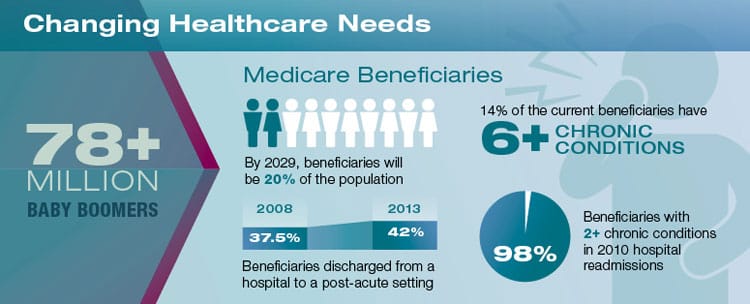As a healthcare professional, keeping up with the key trends that drive consumers’ decisions is integral to your success and the health of your patients. There are three key consumer trends, all heavily influenced by the Baby Boomer population, driving the industry in 2017 and beyond that you should know about.
Changing Healthcare Needs
The Baby Boomer generation – those more than 78 million individuals born between 1946 and 1964 – have had an undeniable impact on nearly all aspects of society. As this population reaches retirement and Medicare enrollment, they are shaping how, where and when healthcare is delivered. Key factors that will shape what an evolving healthcare system will need to address for this aging population are:
- By 2029, Medicare beneficiaries will account for more than 20% of the nation’s population.
- 14% of the current 54 million Medicare beneficiaries have more than 6 chronic health conditions.
- Between 2008 and 2013, the percentage of Medicare beneficiaries discharged from a hospital to a post-acute setting increased from 37.5% to nearly 42%.
- Of the 1.9 million Medicare hospital readmissions in 2010, beneficiaries with two or more chronic conditions accounted for 98 percent of these readmissions.

Key Consumer-driven Trends
Today, consumers – including Medicare-eligible Baby Boomers – are more engaged and have significantly greater influence on healthcare and wellness. Meeting these future healthcare challenges will require more resources, new approaches to care delivery and a greater focus on prevention.
1 - Choices Driven by Price
The significant increase in health costs is contributing to consumers forgoing care until such time that the health concern has escalated and is a larger, more expensive problem.
Why is this Important?
As more consumers become eligible for Medicare coverage, this trend is reversed. Beneficiaries enrolled in traditional fee-for-service Medicare have:
- Fewer/lower out-of-pocket costs
- A wider choice of physicians
- Fewer restrictions on care
With fewer out-of-pocket costs, seniors demand access to the full range of care solutions available to them. This presents an opportunity for physicians, hospitals and other providers to act as a resource detailing healthcare options that best meet a beneficiary’s medical and wellness needs.
2 - Transparency & Accountability
Consumers want to be more empowered when it comes to their health, so they are taking advantage of unprecedented access to information to make educated decisions. Readily available data on patient engagement, care outcomes and quality measurement are at the hands of consumers:
- Online review sites, such as Yelp, Facebook, Care.com, among others. These platforms offer a trusted space to access firsthand experiences of other consumers.
- Star-Rating Systems. Of the current ratings systems online, the most prevalent are 5-star ratings, with 5 stars representing exceptional value and 1 or stars illustrating much poorer value. Through Medicare.gov, CMS hosts side-by-side comparisons of doctors, providers, hospitals and more.
Why is this Important?
With a wealth of wide-ranging data available, it is more important than ever that providers perform at the top of their game with high-quality outcomes and strong patient satisfaction; as well as the need to be aware of their reputation online. This will ensure top online ratings that consumers will turn to first in making health decisions.
3 - Patient-Centric Care
With consumers increasingly taking an active role in health decisions for themselves and their families, patient-centered care models are rapidly emerging. This includes a distinct move away from fragmented care services to fully integrated models that coordinate patient care.
Why is this Important?
Consumers are looking for options that support their active and internet-connected lifestyle. This has given rise to new wearable health-monitoring devices that connect individuals with care providers, specialists, and insurance companies. This is especially useful for patients living with chronic conditions and those living in rural communities. Additionally, CMS continues to test new payment and delivery systems under its Innovation Center.
The Kindred Experience

Over the course of the past several years, we at Kindred have been preparing for reformed health systems and meeting the demands of evolving consumer needs. This includes:
- Testing new payment models through the Independence at Home initiative and ownership of an Accountable Care Organization
- Developing quality measurement across multiple care settings
- Creating effective partnerships with high-profile hospitals and health systems
- Providing 24/7 consumer resources to help patients and their families navigate a complex healthcare system. Through 1.866.KINDRED our Registered Nurses help families through a complicated health system, provide helpful resources and follow up on patient needs post-discharge.
The full spectrum of Kindred’s efforts is focused on providing care coordination across an entire episode of care, and in delivering home-based physician services to support wellness and prevent individuals from requiring a costly hospital stay. This patient-centered care approach has resulted in improved quality outcomes such as reduced rates of hospital readmission, shorter lengths of stay, smoother transitions of care between settings and sustained independence at home.